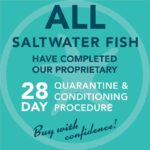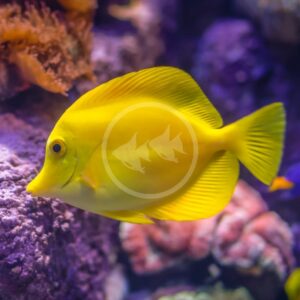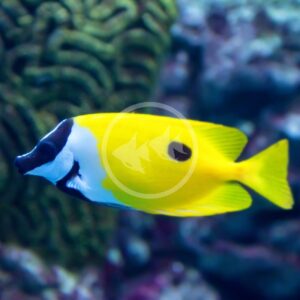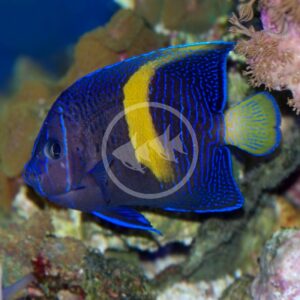

WRASSE – FORMOSA / QUEEN CORIS Coris formosa
$0.00 – $199.99
The Formosa Wrasse, also known as the Queen Coris Wrasse, is found across the Indo-Pacific, Red Sea, and Coral Sea. Like all wrasses in the genus Coris, the Red coris wrasse absolutely requires a several-inch deep medium to fine sandy substrate in order to be able to bury themselves at night for protection or if felt threatened during daylight. In fact, it is very common for your newly introduced wrasse to immediately bury themselves once released into the aquarium. Juvenile Formosa wrasses have a deep red to burgundy body, a clear caudal fin, several white stripes on the body that extend into the dorsal fin, a black spot in the dorsal fin, and the dorsal and anal fins are edged in black. A Formosa wrasse will lose these markings as it matures into an adult. The coloration of the body transitions also, incorporating hues of green and tan with black spots, reddish fins, and a yellow forehead with a blue diagonal line behind the eye. A juvenile Formosa wrasse should not be mistaken for the similarly looking, and perhaps more common, juvenile Red Coris Wrasse (Coris gaimard). An adult Formosa wrasse can reach an impressive size of 20″ in the wild, but often does not exceed 8″ in the home aquarium.
Care Level: Moderate
Temperament: Semi-Aggressive
Reef Compatible: With Caution
General Description: The Formosa Wrasse, also known as the Queen Coris Wrasse, is found across the Indo-Pacific, Red Sea, and Coral Sea. Like all wrasses in the genus Coris, the Red coris wrasse absolutely requires a several-inch deep medium to fine sandy substrate in order to be able to bury themselves at night for protection or if felt threatened during daylight. In fact, it is very common for your newly introduced wrasse to immediately bury themselves once released into the aquarium. Juvenile Formosa wrasses have a deep red to burgundy body, a clear caudal fin, several white stripes on the body that extend into the dorsal fin, a black spot in the dorsal fin, and the dorsal and anal fins are edged in black. A Formosa wrasse will lose these markings as it matures into an adult. The coloration of the body transitions also, incorporating hues of green and tan with black spots, reddish fins, and a yellow forehead with a blue diagonal line behind the eye. A juvenile Formosa wrasse should not be mistaken for the similarily looking, and perhaps more common, juvenile Red Coris Wrasse (Coris gaimard). An adult Formosa wrasse can reach an impressive size of 20″ in the wild, but often does not exceed 8″ in the home aquarium.
Diet Requirements: Formosa wrasses are carnivores. A diet consisting of various meaty preparations such as brine shrimp, mysis shrimp, mussels, clams, krill and other mixed frozen foods that contain algae, such as spirulina, will maintain optimal health and coloration. We highly encourage soaking frozen foods in vitamin and fatty acid supplements, as these wrasses have very high metabolisms. Red coris wrasses will also accept high quality flake or pellet foods, which is great for nutritional gaps and variety.
Care Requirements: An established, minimum 75 gallon aquarium with a 4-5″ sandbed at the very least is needed for a juvenile Formosa wrasse. However, the tank may need to be upgraded accordingly as it matures, or for a smaller adult specimen (125 gallon). A tight fitting lid is a must because these wrasses are known to jump out of aquariums. Formosa wrasses enjoy a variety of rock work and crevices to swim through and around while they actively hunt, but make sure to leave some open sandbed space for burying. A juvenile Formosa wrasse could be kept in a reef aquarium, but various invertebrates including featherdusters, crabs and shrimp are at risk of being eaten. An adult Formosa wrasse can be more destructive as they are capable of reaquascaping some of the rock work, making it not a good reef inhabitant. Therefore, a Formosa wrasse would be bested added to a fish only with live rock aquarium, and with other tank mates that match its energetic and bold disposition such as triggerfish, pufferfish, larger angelfish, and tangs. Avoid timid and docile fish species that are subject to bullying. Recommended water conditions, 72-78° F, KH 8-12, pH 8.1-8.4, salinity 1.020-1.025.
Purchase Size: Juvenile Small: 2″ or less; Medium: 2-1/4″ to 3″; Large: 3-1/4″ to 3-3/4″; Adult Medium: 4-1/4″ to 5-1/2″; Large: 5-3/4″ to 7″
Note: Your item may not look identical to the image provided due to variation within species. Purchase sizes are approximate.
Dry goods orders are shipped via US Postal Service or UPS to the address provided at checkout based on the selection made in your website shopping cart. Product is carefully packed to help prevent any damage during shipping. Once processed you will receive a shipment notification via email with tracking number, and delivery notification. Please allow 48 hours for processing after your order is placed.
Perishable items (i.e. live plants, refrigerated/frozen foods) are shipped via US Postal Service 2-3 day to the address provided at checkout for a $25.00 flat rate charge. Items are packed with secure packing material and heat, cold, or Cryo packs as needed to maintain safe temperatures during transit. If one or more perishable items are in the shopping cart at checkout the $25.00 perishable shipping charge will automatically appear and need to be selected. Once processed you will receive a shipment notification via email with tracking number. Please allow 48 hours for processing after your order is placed.
Livestock (i.e. fish, invertebrates, coral) are shipped via UPS Overnight to the address provided at checkout for a $55.00 flat rate charge. Livestock is packed in insulated styrofoam boxes with secure packing material and heat, cold, or Cryo packs as needed to maintain safe temperatures during transit. If one or more livestock items are in the shopping cart at checkout the $55.00 livestock shipping charge will automatically appear and need to be selected. Livestock is shipped Monday through Wednesday ONLY (no weekend delivery is available) weather permitting, and we reserve the right to delay shipping until conditions are appropriate for safe arrival. Once your order is placed we will contact you to arrange the best shipping date based on these criteria. Someone must be available to receive the livestock order on the first delivery attempt. Once processed you will receive a shipment notification via email with tracking number. Please allow 48 hours for processing after your order is placed.
For mixed dry goods/perishable & livestock orders items will be shipped via their corresponding shipping methods outlined above. Dry goods will be shipped via US Postal Service or UPS based on your selection and checkout, while livestock will ship via UPS Overnight for a $55.00 flat rate charge. You will receive separate notifications and tracking numbers for the dry goods and livestock. Please note due to different carriers and shipping methods dry goods and livestock may arrive on different days.
Related products

TANG – BLUE HIPPO Paracanthurus hepatus
$119.99 – $299.99
MINNOW – WHITE CLOUD MOUNTAIN GOLD
Tanichthys albonubes
$5.99


TANG – YELLOW Zebrasoma flavescens
$174.99 – $399.99

RABBITFISH – ONE SPOT FOXFACE Siganus unimaculatus
$119.99 – $169.99

BUTTERFLY – HENIOCHUS BLACK & WHITE Heniochus acuminata
$119.99 – $249.99

TRIGGER – HUMU HUMU Rhinecanthus aculeatus
$89.99 – $139.99

RABBITFISH – TWO BARRED Siganus virgatus
$89.99 – $199.99




